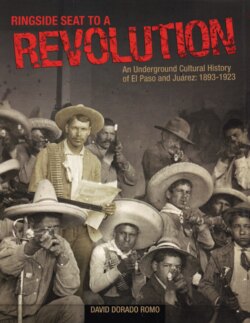Читать книгу Ringside Seat to a Revolution - David Dorado Romo - Страница 9
На сайте Литреса книга снята с продажи.
Оглавление3
PROLOGUE:
A PSYCHOGEOGRAPHY OF TWO CITIES
I’VE BEEN LOOKING for Pancho Villa for the
last four years. I didn’t intend to. When I began writ-
ing this book, it was meant to be a psychogeography,
not a history. In 2001, I was the artistic director of the
Bridge Center for Contemporary Art and had just
received a grant from the Fideicomiso-Rockefeller
Foundation out of Mexico City to chart El Paso’s and
Juárez’ underground cultural life and its various zones.
My project was inspired by the Situationnistes, an
obscure but now-defunct group of mostly French
urbanists, artists and anarchists who in the 1950s
would drift through the streets of Paris charting its
different zones and ambiences. Sometimes they
wandered through the streets of Paris using a map of
Berlin. Some of them got lost; others went crazy. They
wanted to use their maps of the emotional vibes emit-
ted by their city to create a revolution. They drifted
into the Bizarre Zone, the Happy Zone, the Utilitarian
Zone, the Noble Zone, the Sinister Zone, the Zone
Where One Could Go Mad. It was all very avant-garde
stuff. Very French. A little too out there maybe.
Yet I thought they were on to something. Their
idea of the city as a koan, an archeological dig, a puz-
zle, intrigued me. I too wanted to investigate the
unknown nooks and crannies of my city, its hidden
poetry.
So I tried it. I did feel a little odd at first making
a psychogeographical map. After all, I’m not French
and this place isn’t Paris.
I was raised in both Juárez and El Paso, but I’ve
spent a large part of my life trying to get as far away
from both of these cities as possible. If you walk
through downtown El Paso after 5 p.m., you’ll find
that the place is dead. Mostly there are just a lot of
loan shark agencies and trinket shops inside neglect-
ed old buildings. There’s more action in Juárez. But it
didn’t appeal to me either. There was too much suf-
fering there.
So pretty much from an early age I wanted out. I
wanted to go some place where things were happen-
ing—where matters of significance occurred. I didn’t
want to live on the border, on the edge of the world.
I wanted a cosmopolitan cultural center, a city with a
busy nightlife, museums, bookstores, theaters, lots of
history and no Border Patrol. I didn’t know back then
that the Border Patrol is everywhere. But as soon as I
graduated from high school, I split. I spent four years
in northern California, two-and-a-half in Jerusalem
and five years in Florence, Italy.
But something kept drawing me back to this
desert, this place that so many consider nothing more
than a vast cultural wasteland. My family and friends
